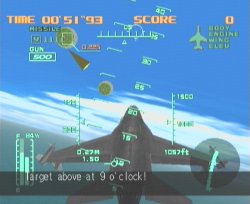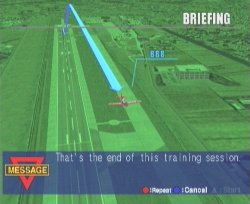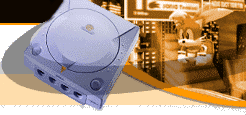| |
AeroWings 2: Air Strike
It tastes a bit better the second time up - Review By Holy Hand Grenade
 For awhile now the "new classics" have been playing on TNT, and it just so happened that the great 80's movie Top Gun was
airing this week. After watching it in its entirety (again) and being a military airplane nut in general, I was pretty psyched about taking
AeroWings 2: Air Strike out for a spin. This is CRI's second crack at
a Dreamcast flight sim, following the original AeroWings which was released in the
States back in September '99. Although the original's focus was on the
nuances of formation flight, for this sequel CRI had the oh-so-original idea
of adding a little violence to the mix.
For awhile now the "new classics" have been playing on TNT, and it just so happened that the great 80's movie Top Gun was
airing this week. After watching it in its entirety (again) and being a military airplane nut in general, I was pretty psyched about taking
AeroWings 2: Air Strike out for a spin. This is CRI's second crack at
a Dreamcast flight sim, following the original AeroWings which was released in the
States back in September '99. Although the original's focus was on the
nuances of formation flight, for this sequel CRI had the oh-so-original idea
of adding a little violence to the mix.
Going strictly by the picture on the cover and by what the name "Air Strike"
implies, players may be a little confused when learning what this game is
really about: it's more a game of military skill acquisition and flight
training than an air combat brawl. Think more along the lines of
Pilot Wings, not Air Force Delta or Ace Combat, and
you'll get the picture. To tell you the truth, there are only a handful of
missions where the player is required to actually shoot down enemy planes
with guns or missiles. On the other hand, there are a lot where the skill acquisition and training take place. There are "Fighter Pilot
Missions" which include 30 exercises designed to teach the player the tricks
of the trade, "Tactical Challenges" that are 15 missions where the player can put his/her skills to the test, "Free Flight" which allows flying
anywhere the player wants with or without enemies, and a VS mode where the
player and a friend can duke it out. So the question is, with all that
AeroWings 2 has to offer, does it have what it takes to make us
Top Gun material, or are we "wannabe Mavericks" forced to look elsewhere to snag our trip to Miramar?
The Good

Shooting deadly balloons. |
Probably the most important element of a flight sim is its
flight model. AeroWings 2 has this ground (or should it be sky?)
covered pretty well, even for sim goers who might have different preferences for flight sim realism. The game accomplishes this by offering two choices of flight dynamics: "Normal" and "Advanced".
In "Normal" mode players don't have to worry about those pesky
laws of physics, and can concentrate on having some slightly more carefree fun. On
the other hand, when flying in "Advanced" mode players will realistically
have to deal with problems like stalling the airflow over the wing if they
climb too quickly, blacking or redding out if the G-forces become too great or few, and a bunch of other nuances of real flight. In both modes,
control with the standard Dreamcast pad's analogue thumb stick feels natural
and precise, and the layout of the commands is about the best one could hope
for with the limited options offered by Sega's controller. A healthy frame rate and a decent
sensation of flight round out the package.
The Fighter Pilot Missions are a successful and enjoyable way for the
player to acquire the proper techniques for everything from simple takeoffs
and landings to all out multi-plane dogfights. The player's performance in
each mission is graded on a scale from 0 to 100, with the criteria
including quickness of completion, air speed, heading and altitude at
specific intervals, ammunition used, etc. Before each mission an effective
and easy to follow briefing of the upcoming exercise is displayed, along with
the comments of a capable voice actor playing the role of your instructor.

The briefing and debriefing screens are wonderfully done, and show you exactly what to do (or what went wrong). |
As the instructor rattles off the criteria for successful completion of the
exercise, an animated 3D map clearly shows players the exact path that should be adhered to for best results. A similar debriefing takes
place after each attempt at the mission, which outlines where the flight
went astray. This briefing/debriefing system does a superb job of
keeping the player on track before the mission and also helping to improve
their score the next time out. Nicely done CRI!
Once players have completed the majority of the Fighter Pilot Missions,
they have the opportunity to put their skills to the test in Tactical
Challenges. Here the objective is still to achieve the highest score, but
now now you have to shoot down a certain number of balloon targets or enemy fighters in a specific amount of time. Due to the fact that all the
airplanes in the game have their own advantages and disadvantages, and each
challenge has a unique set of requirements, plane choice plays an important
role in how successful players will be in any given challenge. Playing off
this idea, the reward for successful completion of certain challenges is the
addition of a new airplane to the player's virtual hanger, and this new plane
may allow him/her to complete some other Tactical Challenges more easily.
The joy of playing both the Fighter Pilot Missions and the Tactical
Challenges is that although most players will repeat each mission at least
a few times over, the majority of the missions possess that "just one more
time" charm. It's really nice to feel the urge to try again because you
feel as though you learned something on your last time out, so the following
attempts will continue to improve until you're able to execute the exercise
perfectly. Another thing that helps is the sheer beauty of the airplane
models. We're talking close to photorealistic here, folks! Yup, they really do look that good. CRI's dedication to creating the most realistic
representations of the game's 14 planes is obvious when you see that the high-poly, high-res
models actually include animated control surfaces (elevators, ailerons, rudders and air breaks), engine thrust nozzles, landing gear (with
lights), flaps, the works. I caught myself spending a good portion of my time just watching the gorgeous replays to get a good look at them. Very nice.
Next: The Bad and The Final Word

|

